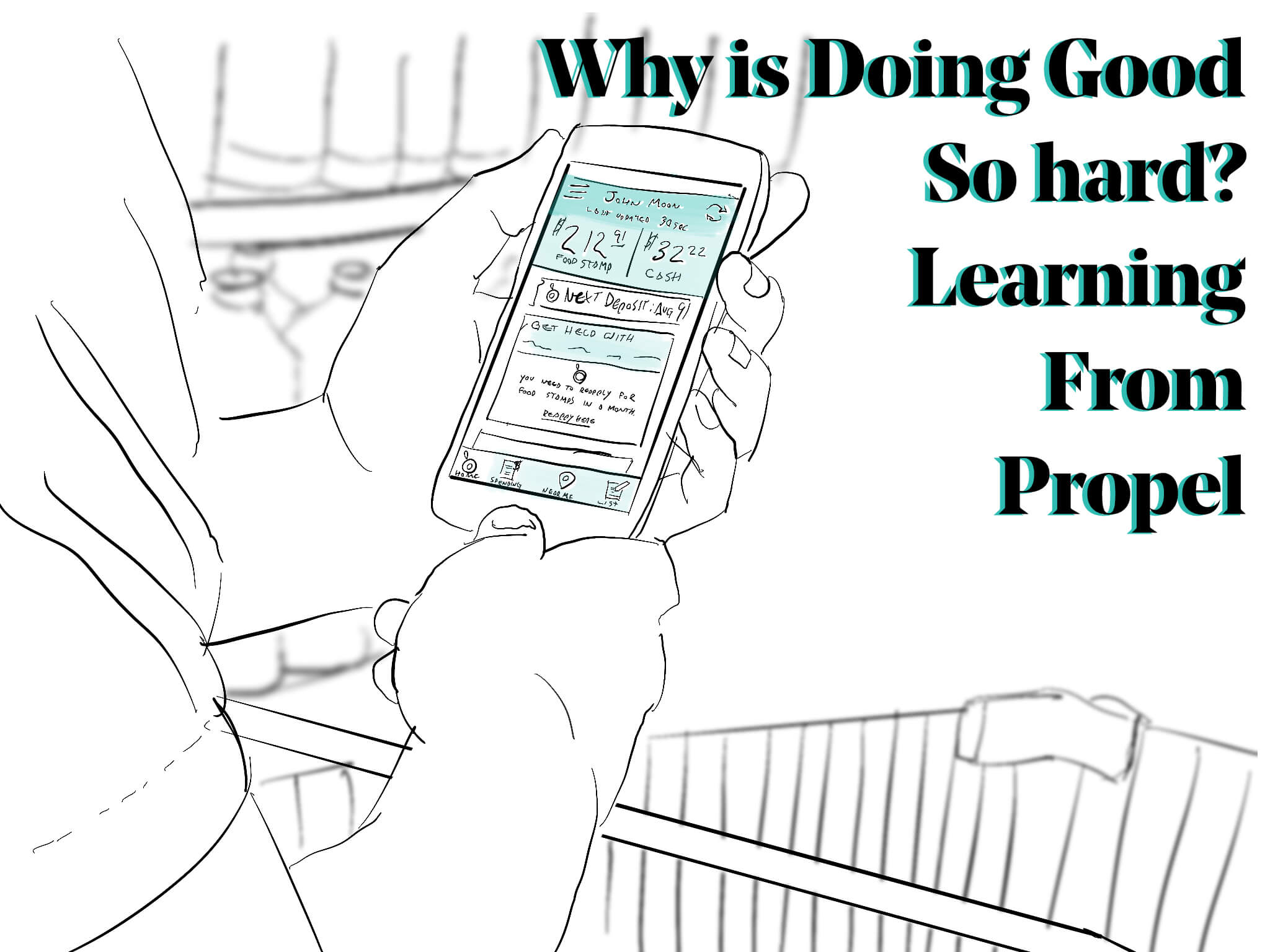Doing good for profit. Learning from Propel

Why the hell is it so hard to do good? Social Product Ventures (SPV) are creating products to do good in the world. Often the product venture part of that equation resembles a traditional software product business. You need engineers to build, maintain, and scale the code base. You need designers to do research and design with your users and customers. You need product managers to scope and shepherd the product itself with an eye to its many stakeholders. These salaries alone represent a very high cost to a SPV that is looking to move past its prototype phase and into a serious product development cycle. Founders, who are often bootstraping off their own savings for a time, also see a high opportunity cost to their own activities.
We see many skilled entrepreneurs who want “doing good” to be their primary business. But they pay for that drive with their savings and alternative earning opportunities because they believe that people’s lives should be better, and they see an opportunity to elevate those lives through technology. So: How might we make the application of product development skills in the public interest not a sacrificial act, but a sustainable and desirable direction for entrepreneurs and their early employees?
I’ve been exploring this question through interviews and discussions with social product entrepreneurs at early, mid, and late stages in their venture. One of those people is Jimmy Chen, the founder of Propel. Jimmy and his team recently closed a seed round led by Andreessen Horowitz and Omidyar Network: significant because Andreessen represents one of the foremost venture capitalists in the software world, and Omidyar is on a similar level in the Impact Investment space. So if you’re a product person like Jimmy wanting to build a Social Product Venture, how do you get from where you are to raising a round to grow the business and its impact?
Jimmy started Propel in 2014 with two co-founders after leaving his role as a Product Manager at Facebook. With the goal of tackling core issues around poverty, they identified the Supplemental Nutrition Assistance Program (SNAP) at the US Dept of Agriculture (USDA) as a mechanism to have a positive impact on people’s social determinants of health. Their initial concept was to develop a “Turbotax for SNAP applications” to help more eligible people apply and get the food stamp subsidies they were entitled to.
With this concept, they were accepted into a nascent accelerator at the Robin Hood Foundation called Blue Ridge Labs (at the time it was called Significance Lab), which gave them office space and a salary for three months to work on their concept. It bought them the time to research, design, develop, and iterate on the product idea: creating something that helped people move through the SNAP system more quickly.
As their time at the accelerator ran out, they ran a kickstarter to continue working on the product, get users through the system, and ultimately pay the rent of the co-founders while the product was being developed. The kickstarter extended their runway, but ultimately they were unable to find funding and the two other co-founders had to leave and find other financial support. Jimmy had personal savings he had carefully set aside, and so was able to continue working on the product as a now solo founder. Unfortunately, that meant he was designing, developing, selling, and managing the existing infrastructure without any income, and without a clear next step for the business.
This is the most common end-point for Social Product Ventures. You’ve created something of value, but you’ve run out of runway for the initial discovery phase and realistically, you don’t have a clear path forward for market testing and iterating on the business model. This is the “we have a prototype, now what?” phase– a painful period of introspection as you reframe the business model and the product around actual market needs. It’s incremental, it doesn’t end with a ‘launch’ date, and sometimes you won’t find a fit.

Jimmy kept going. Over the course of the next ten months, not as much got done, but the product improved incrementally and Jimmy’s knowledge of the foodstamp ecosystem expanded. But in 2015, he applied for and won the Center For Financial Services Innovation (CFSI) Financial Solutions Lab program, which saw CFSI invest $250k in Propel to continue doing this work. This let Jimmy bring on his first hire, Jeff Kaiser, who became the COO, who joined in the fall. Ram Mehta also joined as full time CTO, who had been helping with development as a part-time volunteer.
With this new injection of capital and division of labor, Jimmy, Ram, and Jeff were able to start exploring and questioning the ecosystem around their initial product. They had developed expertise in the SNAP program and the needs of low-income Americans seeking aid through food stamps, but Turbotax for SNAP was a dead-end business model for a For-Profit business. Around this time, Code for America (CfA) was also building solutions in this space, and gov-tech efforts like the US Digital Service (USDS) were making progress in improving the experience of engaging with social services at the federal level. An important question was raised: Is this a space that a For Profit business should be engaging in? And if not, then is it only not-for-profits like CfA or gov-tech organizations like USDS who can move forward with a core social good mission?
I believe that this is one of the core questions underpinning the classification of Social Product Ventures. What Propel demonstrated is that for-profit businesses are an invaluable part of the social good ecosystem. What they discovered next is that their social mission also enabled them to tap into a market that was previously underserved, or served in a predatory fashion.
A key shift happened when Jimmy, Ram, and Jeff started to explore elsewhere in the SNAP customer journey: if you are on foodstamps, what are your other experiences? How do you check your balance? How do you make purchases? What is your mental model around what you can purchase?
Working with food stamp recipients, they learned that the USE of food stamps was rife with technical and user experience challenges that failed to support food stamp users’ needs. So they started to build out a prototype that became FreshEBT (EBT stands for Electronic Benefit Transfer).
FreshEBT allowed you to easily check the balance for your SNAP benefits, so that you were never in a position of not having enough at the checkout line. This has massive value from a dignity standpoint, but also from the perspective of planning and balancing a budget. By including information like reapplication for benefits, when your next deposit was coming, and which SNAP benefit accepting grocery stores were near by, FreshEBT was able to provide a better and more dignified experience to a customer ecosystem that few in the product space had paid attention to before. It also opened up an entirely new market.
About $70 billion dollars in SNAP benefits are spent providing nutritional support for low income families in the United States. What those dollars can buy is regulated, but to the businesses providing SNAP services to their customers, a dollar is a dollar, whether it comes from an EBT card or a credit card. With FreshEBT, these groceries stores suddenly had access to a channel through which they could connect with a core customer base that had previously been lost in the noise. By offering discounts, information, and awareness of SNAP-accepted products, grocers were able to increase their competitiveness, provide value to SNAP recipients, and also present a very clear business model for the team at Propel.
Having surfaced a previously underserved market with $70 billion dollars in purchasing power constrained to better nutrition for low-income Americans, Propel had turned their early insights around food stamps and mission to address poverty into a profitable business that had a positive social mission at its primary profit center. With this as a basis, they were able to fundraise theirSeed as a traditional software startup might, but with a massive competitive edge. They were able to approach both traditional VC investment and impact investment with the same business model, and have both kinds of investment firms understand the value of their product.
Jimmy’s path with Propel was a unique one. While he started as many Social Product Ventures do, he had three unique benefits: a personal financial buffer, a mission (poverty) with a tangible focus (nutrition), and the benefit of Product Management experience at one of the top software startups. His financial buffer enabled him to weather the gap between prototype and funding that is mostly frequently the death of SPVs. The mission and focus enabled him to pivot the business model effectively without losing sight of the social good. Finally, the product management experience gave him a template with which to tackle his day-to-day experience, with all the ambiguity and unknowns that a startup brings.
If you’re starting or want to start a Social Product Venture, what can you learn from Jimmy and Jeff’s experience to think more strategically about the vector you take?
- Find and protect personal capital to create opportunities. The ability to draw from liquid assets means an ability to withstand the unexpected and take beneficial risks. In this case, Jimmy’s savings and risk tolerance bought him the time to get the funding Propel needed to create FreshEBT. This requires planning and foresight to develop this kind of buffer, but by strategically saving and budgeting during the development process, even a small amount can go a long way.
- Start with a regulatory review of your space. Regulatory constraints can massively impede your ability to affect a space, and may determine the corporate vehicle your SPV selects. Propel’s Delaware C structure could have cut them off from certain funding sources, or prevented them from working with EBTs. However, its familiar Delaware C incorporation likely helped in seeking venture funding down the road, as most VCs are optimized along that path. Similarly, if a For-Profit organization is the goal, as Propel’s was, optimizing for VC investment might provide you the runway to present a regulatory challenge and access a previously untapped or constrained markets.
- Get creative and realistic with your burndown rate. Your mechanisms for fundraising might have substantially longer timeframes and different payout mechanisms than angel and VC approaches. Traditional VC might have different milestones for unlocking capital as part of your term sheet, but a foundation grant might be completely different in how it distributes funds. Because the Financial Solutions award was immediate for Propel, it enabled immediate hires and an accelerated timeframe when creating the FreshEBT model.
- Figure out a “retreat and regroup” strategy. Doing good through software is hard and the ecosystem to support this kind of work is still underdeveloped. If things take an unexpected turn, what are the steps you can take to support the product, its mission, and its users while also supporting yourself?
These are just a handful of lessons Social Product Ventures can learn from the work that Jimmy, Jeff, and Ram have done with Propel. I’m continuing to chat with funders and founders of Social Product Ventures to map out this space. If you know anyone I should talk to or want to share some ideas about what I’ve discussed, drop me a note at lovettbarron@newamerica.org